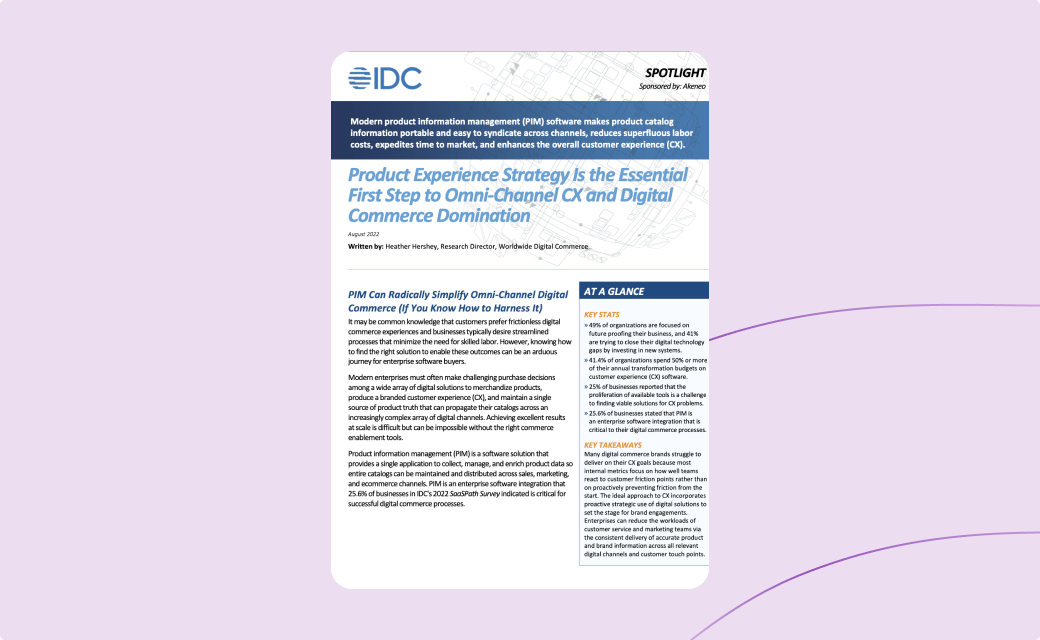PIM can help businesses radically simplify the process of producing a consistent, compelling customer experience across all channels, acting as a proactive step toward an omnichannel commerce strategy.

Keywords
“The future of commerce is customer journey based and channel agnostic.”
It may be common knowledge that customers prefer frictionless digital commerce experiences and businesses typically desire streamlined processes that minimize redundant work.
But in reality, providing consistent and compelling experiences to customers on every single channel can feel like a pipe dream to many organizations, especially as new channels and marketplaces emerge at an almost constant pace.
In order to meet the demands of today’s consumers, businesses must shift their focus to a customer journey-based approach that is inclusive of all channels. This means that businesses will be able to provide a consistent and relevant experience to customers regardless of the channel they are using, whether it be an online marketplace, social media, or a physical store.
By understanding and anticipating the needs of customers at every stage of their journey, businesses can create a coherent, personalized experience that will keep them coming back for more. While this is great in theory, it falls apart when we realize that most organizations aren’t anticipating the needs of their customers; they’re reacting.
Many digital commerce brands struggle to deliver on their Customer Experience (CX) goals because most internal metrics focus on how well teams react to customer friction points rather than on proactively preventing friction from the start.
These same organizations also tend to struggle to create positive customer experiences that persistently influence beyond individual encounters in various, disparate channels. Venturing into new, unfamiliar channels of commerce can be a potentially high-risk, expensive, and time-consuming endeavor if not well controlled. This is true whether the channel is a physical store, marketplace, social media platform, eCommerce site, or new geographical territory.
So, the question becomes, how do these brands and retailers maximize results and reduce expenses, all while proactively providing a consistent and compelling customer experience?
The ideal approach to CX incorporates proactive strategic use of digital solutions to set the stage for brand engagements. Enterprises can reduce the workloads of customer service and marketing teams via the consistent delivery of accurate product and brand information across all relevant digital channels and customer touchpoints. This is where Product Information Management, or PIM, comes into play.
The problem that PIM solves is relatively straightforward: many companies with low or intermediate levels of digital maturity need help getting and staying on top of the developments within the retail landscape, especially after a global pandemic.
PIM can simplify all aspects of product catalog management, creation, and syndication, creating a reduction in user friction points. If the PIM system in question has an excellent, human-centered user experience (UX) design, the amplification of team productivity will be noticeable immediately.
Teams can spend less time on “busywork,” like manually resizing images per the specifications of various social media platforms, and spend more time strategizing their creative assets to engage in the customer experience and enhancement of customer’s journey with the brand.
A PIM solution allows businesses to maintain a single source of truth for their product data, reducing the need for manual labor and expediting time to market. Without it, they may have difficulty maintaining a central product catalog, resulting in incorrect, incomplete, or outdated product data that cannot be easily distributed across conflicting channels.
PIM can help businesses simplify the process of producing a consistent, branded CX across all digital channels, and is a crucial first step toward a coherent omnichannel commerce strategy.
To learn more about how PIM can act as the foundation for providing omnichannel customer experiences, download the IDC Spotlight today, or reach out to an Akeneo expert to see how we can help.

The circular economy presents a powerful opportunity for businesses to align sustainability with profitability by minimizing waste, maximizing...
Read more
Discover what makes Akeneo more than just a workplace. From fostering a culture of care and work-life balance to providing opportunities for growth...
Read more
2024 has been a year to remember for Akeneo. For the third day of PXMas, we’re sharing the stories behind just a few of the prestigious awards...
Read more